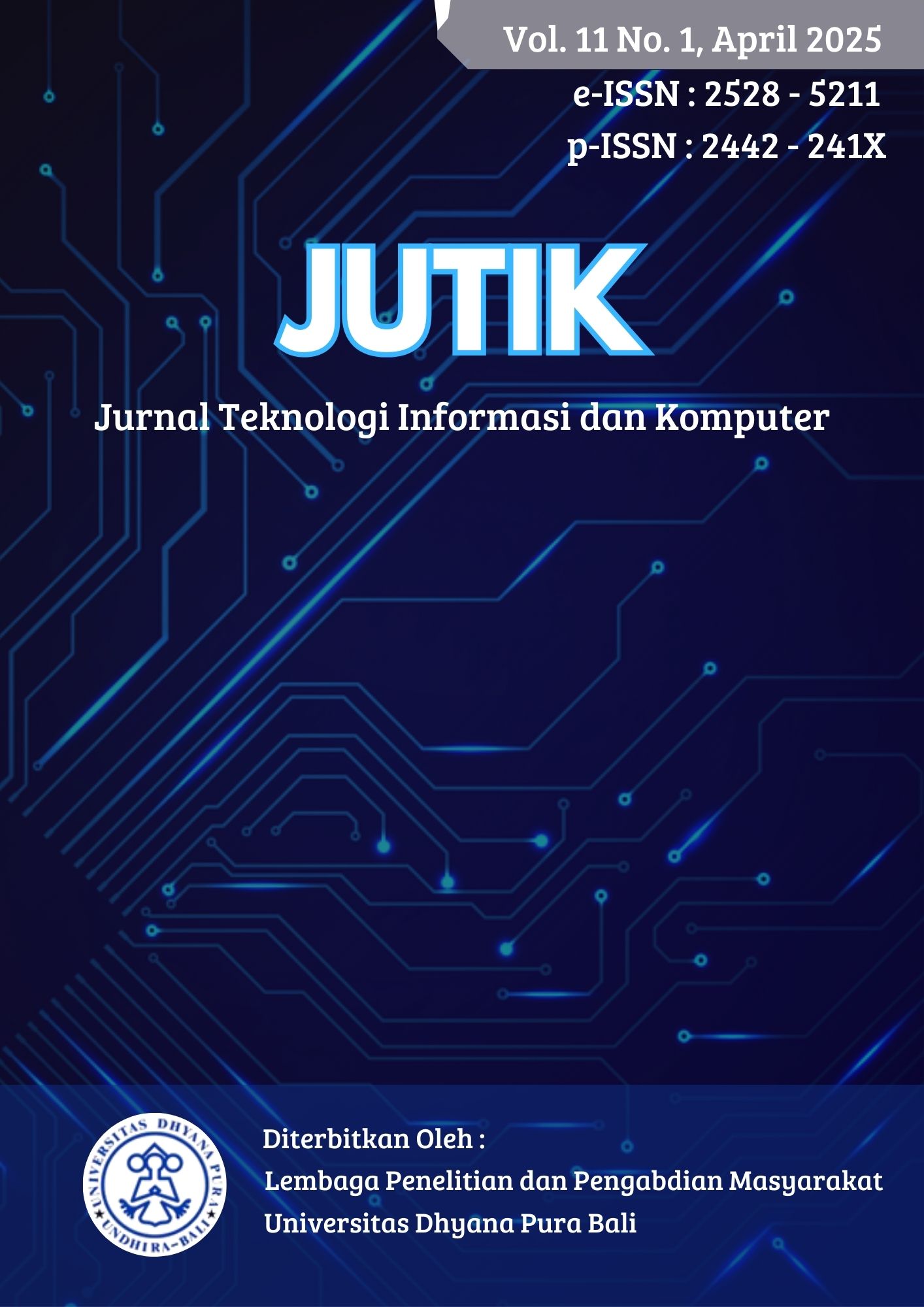PENGUJIAN KUALITAS WEBSITE DINAS KEPENDUDUKAN DAN PENCATATAN SIPIL (DUKCAPIL) KOTA DENPASAR BALI MENGGUNAKAN METODE SYSTEM USABILITY SCALE (SUS)
DOI:
https://doi.org/10.36002/jutik.v11i1.3747Keywords:
System Usability Scale, Website, Quality, InformationAbstract
Websites play a crucial role in providing efficient digital information and services across various sectors, including the government sector. In this sector, an optimal website is a key factor in enhancing public service efficiency, particularly in facilitating public administration and ensuring that population services are conducted more effectively and responsively to meet society's needs. The Civil Registry and Population Office (DUKCAPIL) of Denpasar City is a public service agency that operates an official website at taringdukcapil.denpasarkota.go.id. This website serves as a platform for providing information on public administration and population services. However, its information delivery is still suboptimal, with issues such as user-unfriendly navigation, infrequent information updates, and difficult access to older news content. As a result, users struggle to obtain the necessary information. To assess the quality of the DUKCAPIL website, quality evaluation was conducted using System Usability Scale (SUS) method, which measures usability based on five key dimensions: Easy to Use, User Competence, Efficiency, System Reliability, and Design. The evaluation was carried out in Denpasar City using questionnaires and a random sampling method. Based on the assessment, the DUKCAPIL Denpasar City website was classified as grade F with a "WORST IMAGINABLE" rating, achieving an average score of 26.13.
References
E. R. Karoza, S. Widowati, and A. Gandhi, “Evaluation of The Quality of The School Website using WEBUSE and IPA,†in 2022 International Conference on Data Science and Its Applications (ICoDSA), IEEE, Jul. 2022, pp. 149–154. doi: 10.1109/ICoDSA55874.2022.9862534.
N. Febriani, “User Interface Dan User Experience Webqual 4.0 Rollover-Reaction.Com Untuk Meningkatkan Keputusan Pembelian Konsumen,†Jurnal Teknologi Informasi dan Komputer, vol. 6, no. 2, Jan. 2020, doi: 10.36002/jutik.v6i2.1021.
N. L. S. A. Putri, I. W. Mirta, and G. A. A. Y. Dewi, “Implementasi Sistem Pendaftaran Daring (Si Taring) Dalam Pelayanan Publik Di Dinas Kependudukan Dan Pencatatan Sipil Kota Denpasar,†Journal of Contemporary Public Administration (JCPA), vol. 3, no. 1, pp. 34–41, May 2023, doi: 10.22225/jcpa.3.1.2023.34-41.
K. R. A. Nugraha, K. A. S. Wijaya, and K. W. D. Wismayanti, “Penerapan Digital Government Melalui Website Taring Dukcapil di Dinas Kependudukan dan Pencatatan Sipil Kota Denpasar,†Ethics and Law Journal: Business and Notary, vol. 1, no. 3, pp. 74–81, Nov. 2023, doi: 10.61292/eljbn.v1i3.56.
E. Kurniawan, N. Nofriadi, and A. Nata, “Penerapan System Usability Scale (Sus) Dalam Pengukuran Kebergunaan Website Program Studi di STMIK Royal,†Journal of Science and Social Research, vol. 5, no. 1, p. 43, Feb. 2022, doi: 10.54314/jssr.v5i1.817.
Fenny Purwani and Fatikah aulia farhah, “Usability Testing Analysis On Professional Social Media Using The System Usability Scale (Sus) Method,†Jurnal Perangkat Lunak, vol. 6, no. 3, pp. 392–399, Oct. 2024, doi: 10.32520/jupel.v6i3.3426.
A. A. N. H. Susila and D. M. Sri Arsa, “Analisis System Usability Scale (SUS) dan Perancangan Sistem Self Service Pemesanan Menu di Restoran Berbasis Web,†Majalah Ilmiah UNIKOM, vol. 21, no. 1, pp. 3–8, Apr. 2023, doi: 10.34010/miu.v21i1.10683.
N. Clark, M. Dabkowski, P. J. Driscoll, D. Kennedy, I. Kloo, and H. Shi, “Empirical Decision Rules for Improving the Uncertainty Reporting of Small Sample System Usability Scale Scores,†Int J Hum Comput Interact, vol. 37, no. 13, pp. 1191–1206, Aug. 2021, doi: 10.1080/10447318.2020.1870831.
S. B. Harper and S. L. Dorton, “A Pilot Study on Extending the SUS Survey: Early Results,†Proceedings of the Human Factors and Ergonomics Society Annual Meeting, vol. 65, no. 1, pp. 447–451, Sep. 2021, doi: 10.1177/1071181321651162.
M. Yusuf and Y. Astuti, “System Usability Scale (SUS) Untuk Pengujian Usability Pada Pijar Career Center,†Komputika : Jurnal Sistem Komputer, vol. 9, no. 2, pp. 131–138, Oct. 2020, doi: 10.34010/komputika.v9i2.2873.
R. Albaghli, A. Beidas, and N. Attar, “Eyes on higher education: Evaluating web usability in Kuwaiti private universities using eye-tracking and SUPR-Q metrics,†Journal of Engineering Research, pp. 42–49, Dec. 2024, doi: 10.1016/j.jer.2024.12.001.
A. Kumar and A. Arora, “Website Quality Analytics Using Metaheuristic Based Optimization,†Recent Advances in Computer Science and Communications, vol. 14, no. 3, pp. 895–915, Jun. 2021, doi: 10.2174/2666255813666190911112235.
“An Empirical Study on the Impacts of Quality Information and Competency of User on the Quality of Zakat Management Information System in Indonesia,†Journal of System and Management Sciences, vol. 13, no. 3, May 2023, doi: 10.33168/JSMS.2023.0316.
T. Suryani, A. A. Fauzi, M. L. Sheng, and M. Nurhadi, “Developing and testing a measurement scale for SMEs’ website quality (SMEs-WebQ): Evidence from Indonesia,†Electronic Commerce Research, vol. 24, no. 3, pp. 1763–1794, Sep. 2024, doi: 10.1007/s10660-022-09536-w.
B. J. Jansen, K. K. Aldous, J. Salminen, H. Almerekhi, and S. Jung, “A Discussion of the Validity of Data Analytics,†in 2012 IEEE 19th International Conference on Web Services, IEEE, 2024, pp. 139–145. doi: 10.1007/978-3-031-41933-1_12.
S. A. C. Perrig, D. Ueffing, K. Opwis, and F. Brühlmann, “Smartphone app aesthetics influence users’ experience and performance,†Front Psychol, vol. 14, no. 1, pp. 76–105, Jun. 2023, doi: 10.3389/fpsyg.2023.1113842.
S. Kaur and S. K. Gupta, “A fuzzy-based framework for evaluation of website design quality index,†International Journal on Digital Libraries, vol. 22, no. 1, pp. 15–47, Mar. 2021, doi: 10.1007/s00799-020-00292-6.
M. H. Setiawan, R. Komarudin, and D. N. Kholifah, “Pengaruh Kepercayaan, Tampilan Dan Promosi Terhadap Keputusan Pemilihan Aplikasi Marketplace,†2022. doi: https://doi.org/10.31294/infortech.v4i2.13913.g5725.
F. Tolner, B. Barta, L. Kovacs, and G. Eigner, “Application of MFV-robustified Correlation Coefficient for the Investigation of the Strength of Beta-convergence of EU NUTS regions,†in 2022 IEEE 20th Jubilee World Symposium on Applied Machine Intelligence and Informatics (SAMI), IEEE, Mar. 2022, pp. 000335–000340. doi: 10.1109/SAMI54271.2022.9780675.
F. D. P. Anggraini, A. Aprianti, V. A. V. Setyawati, and A. A. Hartanto, “Pembelajaran Statistika Menggunakan Software SPSS untuk Uji Validitas dan Reliabilitas,†Jurnal Basicedu, vol. 6, no. 4, pp. 6491–6504, May 2022, doi: 10.31004/basicedu.v6i4.3206.
P. A. Raharja and B. Z. Pramudya, “Evaluasi Usability Aplikasi Augmented Reality Morphfun Menggunakan System Usability Scale,†MULTINETICS, vol. 8, no. 2, pp. 122–130, Dec. 2022, doi: 10.32722/multinetics.v8i2.4702.
Downloads
Published
How to Cite
Issue
Section
License
Copyright (c) 2025 JUTIK : Jurnal Teknologi Informasi dan Komputer

This work is licensed under a Creative Commons Attribution-NonCommercial-ShareAlike 4.0 International License.
![]()
This work is licensed under a Creative Commons Attribution-NonCommercial-ShareAlike 4.0 International License.











